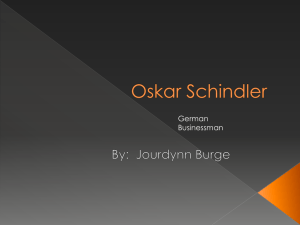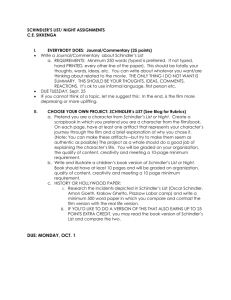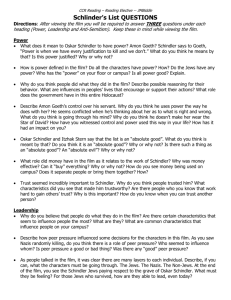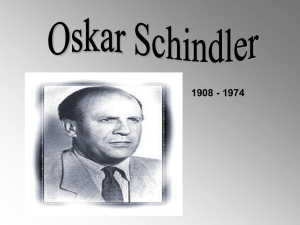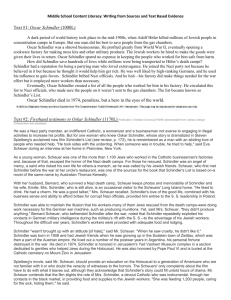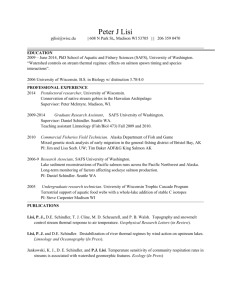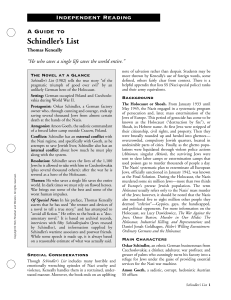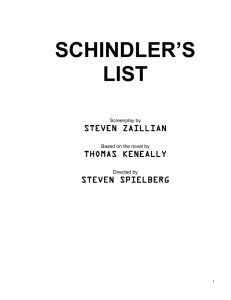Ch 16-17 review sheet L2
advertisement
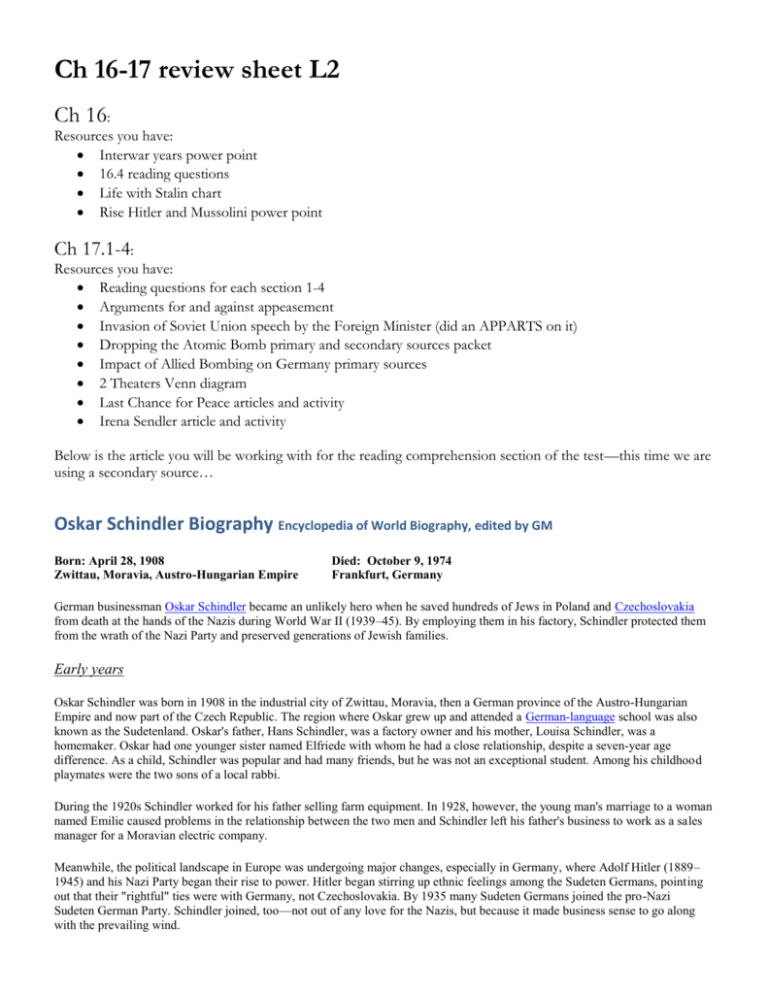
Ch 16-17 review sheet L2 Ch 16: Resources you have: Interwar years power point 16.4 reading questions Life with Stalin chart Rise Hitler and Mussolini power point Ch 17.1-4: Resources you have: Reading questions for each section 1-4 Arguments for and against appeasement Invasion of Soviet Union speech by the Foreign Minister (did an APPARTS on it) Dropping the Atomic Bomb primary and secondary sources packet Impact of Allied Bombing on Germany primary sources 2 Theaters Venn diagram Last Chance for Peace articles and activity Irena Sendler article and activity Below is the article you will be working with for the reading comprehension section of the test—this time we are using a secondary source… Oskar Schindler Biography Encyclopedia of World Biography, edited by GM Born: April 28, 1908 Zwittau, Moravia, Austro-Hungarian Empire Died: October 9, 1974 Frankfurt, Germany German businessman Oskar Schindler became an unlikely hero when he saved hundreds of Jews in Poland and Czechoslovakia from death at the hands of the Nazis during World War II (1939–45). By employing them in his factory, Schindler protected them from the wrath of the Nazi Party and preserved generations of Jewish families. Early years Oskar Schindler was born in 1908 in the industrial city of Zwittau, Moravia, then a German province of the Austro-Hungarian Empire and now part of the Czech Republic. The region where Oskar grew up and attended a German-language school was also known as the Sudetenland. Oskar's father, Hans Schindler, was a factory owner and his mother, Louisa Schindler, was a homemaker. Oskar had one younger sister named Elfriede with whom he had a close relationship, despite a seven-year age difference. As a child, Schindler was popular and had many friends, but he was not an exceptional student. Among his childhood playmates were the two sons of a local rabbi. During the 1920s Schindler worked for his father selling farm equipment. In 1928, however, the young man's marriage to a woman named Emilie caused problems in the relationship between the two men and Schindler left his father's business to work as a sales manager for a Moravian electric company. Meanwhile, the political landscape in Europe was undergoing major changes, especially in Germany, where Adolf Hitler (1889– 1945) and his Nazi Party began their rise to power. Hitler began stirring up ethnic feelings among the Sudeten Germans, pointing out that their "rightful" ties were with Germany, not Czechoslovakia. By 1935 many Sudeten Germans joined the pro-Nazi Sudeten German Party. Schindler joined, too—not out of any love for the Nazis, but because it made business sense to go along with the prevailing wind. In Poland On September 1, 1939, Hitler invaded Poland, prompting Great Britain and France to declare war on Germany. Within a week, Schindler arrived in Krakow, Poland, eager to find a way to profit from the conflict in one way or another. In mid-October, the city became the new seat (central location) of government for all of Nazi-occupied Poland. Schindler quickly created friendships with key officers in both the Wehrmacht (the German army) and the SS (the special armed Nazi unit), offering them black-market (illegal) goods such as cognac and cigars. It was around this same time that he met Itzhak Stern, a Jewish accountant who would eventually help his relations with the local Jewish business community. Schindler purchased a bankrupt kitchenware factory and opened it in January 1940. Stern was hired on as the bookkeeper and soon developed a close relationship with his employer. Schindler relied on his legendary flair as well as his willingness to bribe the right people to secure numerous German army contracts for his pots and pans. To staff his factory, he turned to Krakow's Jewish community, which, Stern told him, was a good source of cheap, reliable labor. At the time, some fifty-six thousand Jews lived in the city, most living in ghettos (poor neighborhoods that were traditionally reserved for Jews). By the spring of 1940, the Nazi crack-down against Jews had begun. Schindler was ordered to pay his Jewish employees' wages directly to the SS rather than to the workers themselves. In August Nazi authorities issued a new regulation ordering all but "workessential" Jews to leave the city. This sparked the panic that sent Jews scrambling for work that would be considered "essential." His work begins In June of 1942, the Nazis began relocating Krakow's Jews to labor camps. Some of Schindler's workers, including his office manager, were among the first group of people ordered to report to the train station. Schindler raced to the station and argued with an SS officer about how essential his workers were to the war effort. By dropping the names of some of his Nazi friends and making a couple of threats, he was finally able to rescue the workers and escort them safely back to his factory. In early 1943 the Nazis ordered the final "liquidation" of the Krakow ghetto. The man put in charge of the operation was a young SS officer named Amon Goeth, the commandant of the Plaszow forced labor camp just outside the city. Jews who were healthy and could work were sent to Plaszow and the rest were sent off to death camps or executed on the spot. When Goeth announced that local industries would be moved inside Plaszow, Schindler proposed establishing a labor mini-camp within his factory that would continue to employ his own workers. Goeth agreed after Schindler bribed him. The list In early 1944, however, Plaszow's designation was changed from that of a labor camp to a concentration camp. This meant that its prisoners were suddenly marked for transport to death camps such as Auschwitz. Then came word in the summer that the main camp was to be closed as well as Schindler's factory. Schindler approached Goeth about moving his factory and his workers to Czechoslovakia so that they might continue to supply the Third Reich (Hitler's army) with vital war supplies. After another bribe, the SS officer agreed to throw his support behind the plan and told Schindler to draw up a list of those people he wanted to take with him. Schindler was now faced with the task of choosing those he wanted to save—literally a matter of life and death. Schindler came up with a list containing some eleven hundred names, including all the employees of Emalia Camp and a number of others as well. During the fall of 1944, Schindler made the necessary arrangements (and paid the necessary bribes) to begin the process of moving his factory to the town of Brunnlitz, Czechoslovakia. The liquidation of the Plaszow camp began that October. Shortly after around eight hundred men were shipped out in boxcars bound for Brunnlitz. Three hundred women and children who were supposed to join them there were mistakenly routed to Auschwitz instead. Schindler immediately rescued these women and children, and they were sent on to Brunnlitz. Over the next seven months, Schindler's factory never produced a single useful shell (the outer casings for bullets). He called it "start-up difficulties" when, in reality, he had purposefully weakened the manufacturing process to make sure that the shells failed quality-control tests. End of the war Finally, on May 8, 1945, the war came to an end after Germany surrendered. Schindler gathered all of his workers together on the factory floor to pass along the good news. He then asked them not to seek revenge for what had been done to them and called for a moment of silence in memory of those who had died. He also thanked the members of the SS who were present and encouraged them to go home peacefully and without further bloodshed…A couple of days later, the twelve hundred or so Schindlerjuden ("Shindler's Jews") were freed by a lone Russian officer who rode up to the factory on horseback. After World War II The same year Schindler lost his cement business (1961), he was invited to visit Israel for the first time. He was delighted with the warm reception he received, which contrasted sharply with his treatment at home. Many of his countrymen were angry with him for saving Jews and testifying in court against Nazi war criminals. Every spring for the rest of his life, he returned to Israel for several weeks to bask in the admiration of the Schindlerjuden and their offspring, whom he regarded with great affection as his own family. Shortly after Schindler's fifty-fourth birthday in 1962, he was officially declared a "Righteous Gentile (non-Jew)" and invited to plant a tree on the Avenue of the Righteous leading up to Jerusalem's Yad Vashem Museum, a memorial to the Holocaust, the name for the German liquidation of Jews during World War II. Upon his death from heart and liver problems in 1974, he was granted his request to be buried in Israel. About five hundred Schindlerjuden attended his funeral and watched as his body was laid to rest in the Catholic cemetery on Mount Zion in Jerusalem. Thanks to Oskar Schindler, more than six thousand Holocaust survivors and their descendants were alive in the 1990s to tell the remarkable story of "Schindler's List." For More Information Read more: http://www.notablebiographies.com/Ro-Sc/Schindler-Oskar.html#ixzz30g7xTs00
